How Payment QR Codes in Vietnam Fuel Its Economic Growth
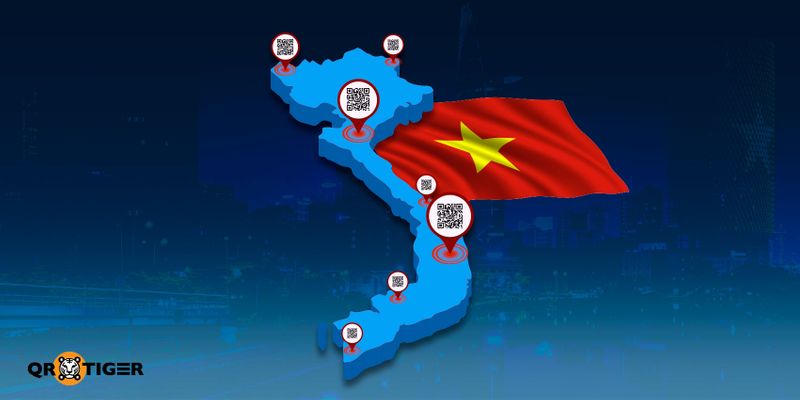
Over 60% of people prefer to use the QR code in Vietnam to facilitate cashless transactions, according to Visa.
Payment QR codes successfully reached a new milestone in 2025 as Vietnam launched a cross-currency service and a cross-border payment system with China, Japan, South Korea, and other South East Asian countries.
This system, powered by an advanced QR code generator, continues to lead the impressive boom of digital payment adoption in the country.
In this guide, we’ll walk you through how QR payments are faring in Vietnam, why they’re becoming essential, and where you can use them during your stay.
Table of Contents
Scan-to-pay: The biggest usage of the QR code in Vietnam
Vietnam is one of the fastest-growing QR code payment markets in Southeast Asia and the leading country with the highest number of e-wallet users.
A recent Visa study highlights that 62% of Vietnamese use a QR code for payment transactions. They scan them on an average of 16.2 times a month, more frequently than using a card.
This change didn’t happen overnight, though. Since the COVID-19 pandemic, Vietnam has been slowly shifting to cashless payment methods.
By 2023, cashless payment transactions soared to 11 billion. This marked a 172% increase, noted by the Vietnam Bank Card Association (VBCA).
Digital banking also adopted new technologies during this time, like eKYC and biometric authentication.
In 2024, it rose by another 20% and Vietnam updated its laws on digital banking and cashless payments to help support the innovations.
As it stands, the reason they are such a popular choice in Vietnam for cashless payments is that they are fast, convenient, and eliminate the need for physical cash or cards.
These quick-response codes allow you to pay just by using the QR code generator with logo of mobile payment apps like MoMo, VNPay, ZaloPay, or other supported international banking apps in Vietnam.
They make card payments easier to complete, which opens up new opportunities to improve the economy in major cities like Hanoi, Ho Chi Minh City, and Da Nang.
Mobile payment apps like MoMo, ZaloPay, or VNPay are capable of generating a simple QR code payment for foreigners in Vietnam, allowing them to shop freely without having to worry about local currency.
And for small businesses, using the QR code from Vietnam banks offers a more cost-effective alternative to card machines.
As of 2024, Vietnam ranks sixth with the highest QR code usage worldwide, with 58.3% of the Vietnamese population using QR codes every month.
How to pay with QR code in Vietnam
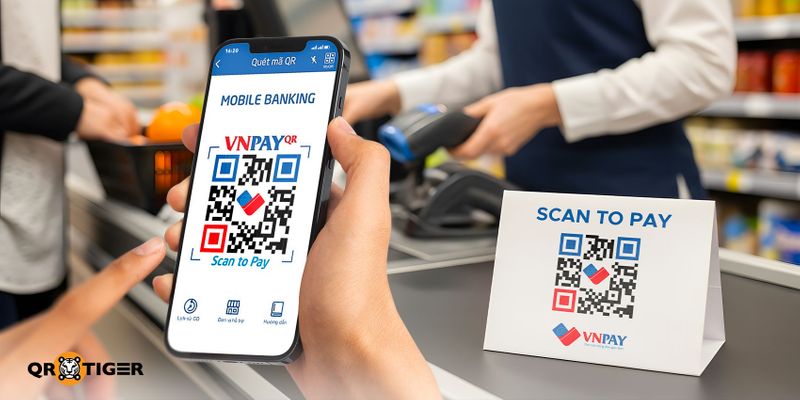
If you’re new to Vietnam’s cashless scene, these are the general steps on how to make transactions using QR codes:
1. Download a mobile payment QR code app (e.g., Momo, Zalopay, and VNPay)
2. Link your bank account or set up a new digital wallet.
3. Using the app, scan the merchant’s QR code.
4. Enter the payment amount and your PIN.
5. Wait for the confirmation receipt.
8 Practical use cases of Vietnam QR code payment
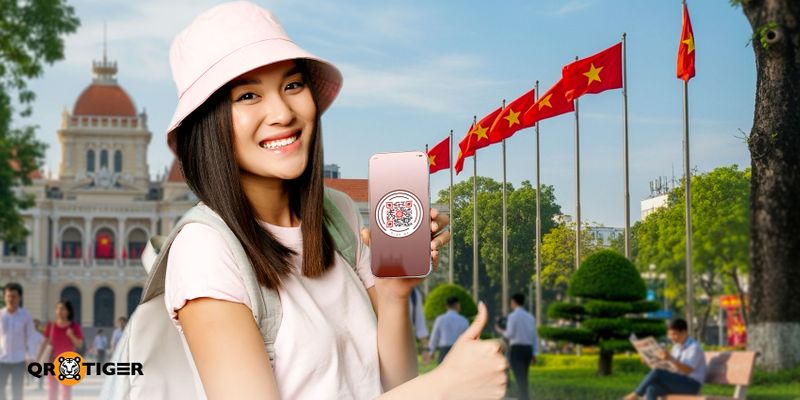
Whether you’re buying street food, hailing a ride, or checking into a hotel, chances are you’ll encounter a QR code ready to be scanned.
Below are seven of the most common and practical uses of QR codes across Vietnam today:
1. Restaurants and cafes
Using a QR code from Vietnamese online banks is becoming the go-to method for settling the bill, from trendy rooftop bars in Ho Chi Minh City to cozy coffee shops in Hanoi.
By placing a QR code on the table, customers can easily pay the bill for their food without ever having to leave their seats.
Resorts like the Azure Beach Lounge in Danang also use a digital ordering system powered by QR codes to open their menus, allowing them to order directly from their tables.
If you want to increase a restaurant's popularity, you can easily do so by using an advanced QR code software.
You can use it and create a menu QR code to streamline food ordering or a multi-language QR code campaign to cater to a wide range of customers.
2. Transportation
Instead of fumbling for change, QR codes make transportation easier and less of a hassle.
Using apps like Grab (Vietnam’s most popular ride-hailing app), people can easily scan a QR code to pay the driver directly without ever having to grab their wallets.
Even buses and trains are starting to adopt QR codes for transportation, making travel smoother for locals and tourists alike.
3. Tourist spots
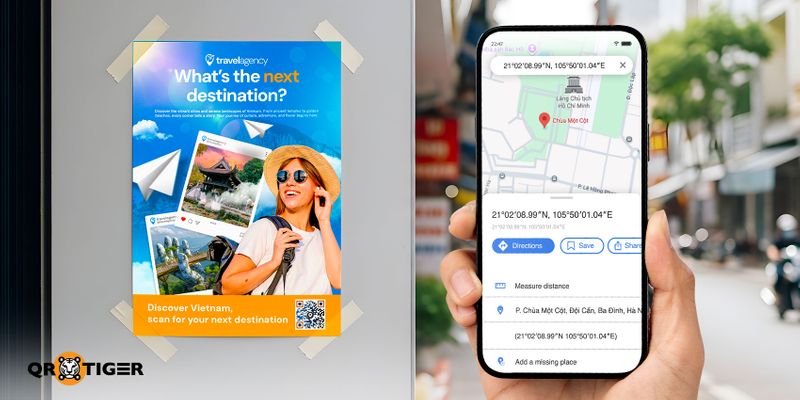
Vietnam’s cultural and historical sites are also embracing Vietnam’s new QR code solutions.
Museums and amusement parks now display QR codes at ticket counters, letting you pay entrance fees in seconds.
Some historical destinations in Vietnam even use a location QR code generator to grant people access to a variety of digital guides or maps of the area.
This makes sightseeing more interactive, allowing people to spend more time enjoying the experience rather than wondering how much it costs.
4. Convenience stores and supermarkets
Major chains like Circle K and FamilyMart in Vietnam also started accepting QR codes at checkout, making grocery runs hassle-free.
It’s especially handy for quick purchases like bottled water and snacks, letting customers pay online so you don’t have to carry coins or wait in long lines.
5. E-commerce sites
Vietnam’s booming online shopping scene is also advancing due to Vietnam QR codes.
Platforms like Shopee, Lazada, and Tiki rely heavily on QR codes to pay sellers in Vietnam and handle shipment tracking as well.
Food delivery apps like GrabFood also offer QR code options at checkout, allowing customers to pay securely and instantly.
Solutions like these help reduce failed transactions and make digital shopping much smoother.
6. Local markets
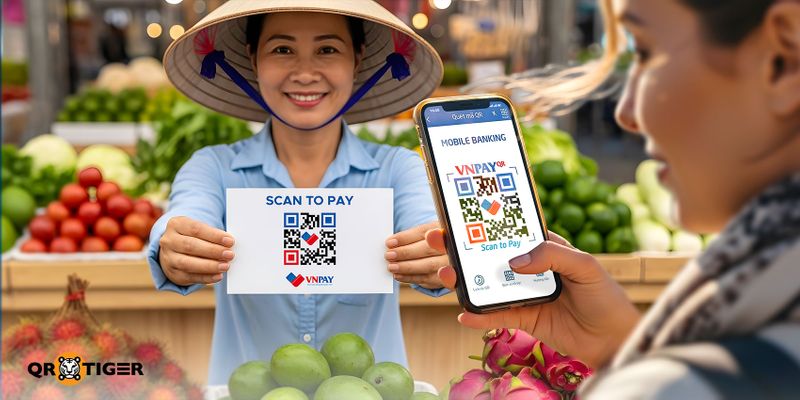
Beyond malls and branded stores, even traditional markets are adopting QR codes.
Street vendors selling fresh fruit, souvenirs, or handmade crafts can now make use of contactless payment options like the VNpay that Vietnamese vendors use to receive digital payments.
By printing out a free QR code for Vietnam on the app, small businesses can level the playing field and make it easier for tourists to shop without cash.
7. Hotels and guesthouses
Many hotels, hostels, and guesthouses accept QR code payments, allowing guests to check in or check out with just a quick scan.
Aside from that, guests can also use a QR code to pay for extra services, like laundry or room upgrades.
These make it a handy solution for foreigners who use QR codes to pay in Vietnam, and also a great option to boost business for hotels.
8. Culture
Not only are QR codes improving Vietnam’s economy, but it has also gotten to the point where they're slowly being applied to parts of their culture as well.
Lunar New Year (or Tet) is a common holiday celebrated all throughout Vietnam.
As part of the celebration, friends and family members would hand out red envelopes filled with cash (“Lucky Money” as they call it) as a way to pass along blessings of good fortune and wealth to their loved ones.
In 2024, the Lunar New Year came with a surprise as some families started to place a customized lucky money QR code on their children’s accessories, allowing others to easily send them their “Lucky Money” by scanning it.
This sparked an online debate, as some experts argue that the use of QR codes was a way of adapting the tradition for modern times, while others point out that it reduces the whole tradition to a quick transaction.
Whatever the case may be, it seems that in Vietnam, people are coming up with a variety of unique and interesting ways to integrate quick-response codes into their lives and their culture.
Vietnamese companies with remarkable QR code uses
We’ve talked about how common QR codes are in Vietnam. Real-world use cases from brands further proves their influence in the country.
Saigontourist
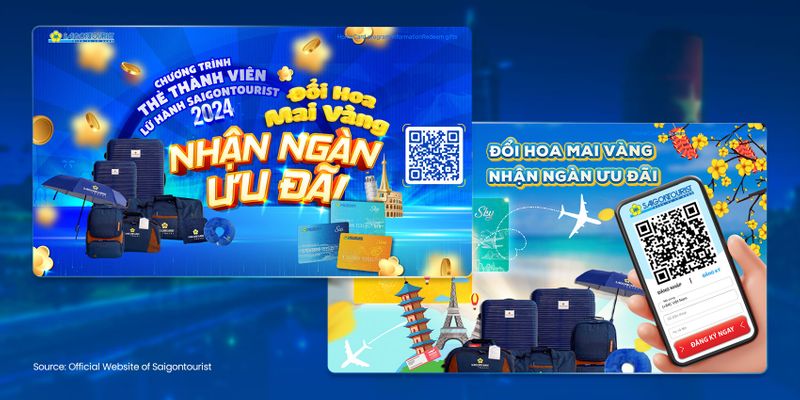
Saigontourist Group has been a top tourism brand in Vietnam since 1975. Now, it uses QR codes to make travel more interactive and fun.
In many of Saigontourist group's current marketing promos throughout social media, customers could scan a QR code to join offers, access details, or register instantly.
The best way this is shown is within the Saigontourist Group’s official website, where the promo header has two QR codes that, when scanned, link to a registry form for their travel card.
At major events like ITB Asia 2023, Saigontourist featured QR codes at its booth, allowing visitors to enter lucky draws, follow fan pages, and complete quick surveys.
Aside from promotional marketing, QR codes are also part of the group’s tourism services. By scanning them, tourists can learn about attractions or quickly give feedback on service quality.
With QR codes, Saigontourist demonstrates how digital tools enhance experiences and build brand loyalty in Vietnam's tourism sector.
Minh Phu Seafood Corporation
Minh Phu Seafood Corporation, Vietnam’s largest shrimp exporter, uses QR codes to make its products more transparent and trustworthy worldwide.
Between 2011 to 2014, the company launched the TraceVerified system. This Denmark-funded platform helped it comply with strict import rules in the US, EU, and Japan.
By scanning QR codes on product labels with their smartphones, consumers and regulators could quickly find out where the shrimp was farmed, how it was processed, and what quality checks it passed.
Minh Phu has since gone further, adding blockchain tools to track real-time data from shrimp farms and processing plants.
Together, these efforts show how a simple QR code can become a powerful tool for helping the Minh Phu Seafood Corporation earn global trust.
HCM City Urban Railway
In celebration of Vietnam’s 80th anniversary of National Day, the HCMC Urban Railway announces that all passengers on the Bến Thành–Suối Tiên metro line will be able to ride for free.
This was done by the HCM City Public Transport Management Centre, as they noted that travel demand is expected to rise on National Day as residents attend celebrations and view fireworks.
To access this promo, passengers needed to scan a citizen ID card or a chip-embedded citizen ID card at the ticket gate. Otherwise, they would have to use a QR code generated via the HCMC Metro HURC app.
Once the app is downloaded, you just need to select the “QR Doc Lap” function and then scan the generated QR code at the ticket gate.
Despite only being available on August 2, there’s no doubt that many people will be able to benefit from using this easy-to-scan code.
Nestle Vietnam
Nestlé Vietnam has made everyday packaging fun with its “One Cap, One Code” campaign. The first of its kind within the country.
Launched in 2021 through a partnership with packaging leader SIG, this project placed unique QR codes beneath the caps of Milo Teen Protein drink cartons.
By scanning the codes with their smartphones, they could collect redeemable points through the Zalo app.
Bonus points for morning scans and friend referrals also added extra incentives, making the process more exciting and encouraging repeat purchases.
This smart use of QR codes connected well with Vietnam’s tech-savvy Gen Z, letting them enjoy fun and rewarding interactions with brands.
Looking ahead: Vietnam’s bright future with QR codes
Vietnam is laying the groundwork for sustained economic growth through QR codes.
As a well-received payment option by the Vietnamese citizenry and tourists, QR code payments stand out as more than just a convenient tool. They also bring financial inclusion, stronger consumer trust, and a more connected economy.
With rising adoption across banks, businesses, and everyday consumers, QR codes are set to play a defining role in shaping Vietnam’s future as a thriving, digitally empowered economy.
If you’re a vendor, retailer, or entrepreneur ready to use QR codes for your business in Vietnam, we highly recommend using the best QR code generator.
Made for professionals and businesses, QR TIGER is a trusted QR code software by more than 850,000 brands worldwide. Try its dynamic QR code solutions today.
FAQ
Is it better to pay with cash or a card in Vietnam?
While having some cash on hand is still great for emergencies, using cards and digital payment options is the best alternative, especially when in urban areas.
In cities like Da Nang or Ho Chi Minh, cards and mobile payments are becoming increasingly common, and even smaller cities like Ninh Binh are slowly making the switch to QR code payments.
Overall, a mix of cash, card, and digital payments is the best approach for a smooth travel experience.
What do I need to enter Vietnam?
If you're planning to experience Vietnam yourself, you will generally need a valid passport and a Vietnam QR code visa in order to travel there.
However, the specific requirements can vary depending on your nationality and the purpose of your travel, so it’s best to check the official Vietnam immigration website for any other requirements or updates.
What are E-visa QR codes?
An e-Visa QR code is a digital code you can scan that shows proof of your approved electronic visa, along with other important travel information.
Applied for online, these QR codes allow border officials to check your immigration status quickly by just scanning the code.
The e-Visa is different from a physical visa sticker as it’s stored digitally and can be accessed online at any time through a country's immigration portal or a mobile app.


